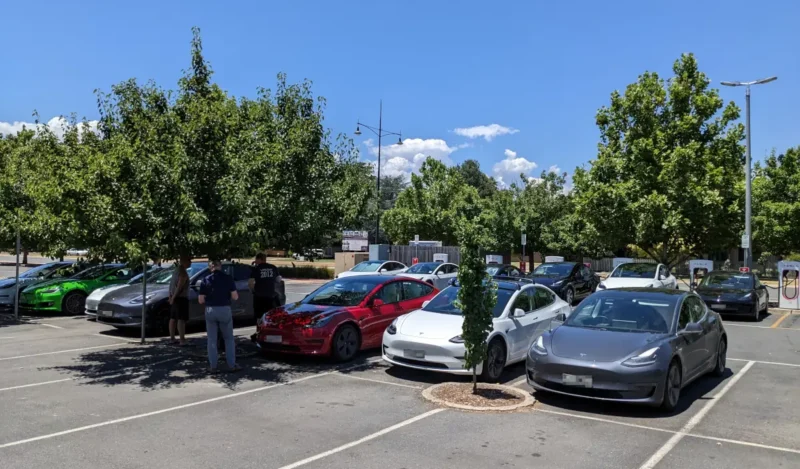Tesla owners in Australia have been notified that congestion fees will replace idle fees at certain busy Supercharger sites, bringing the local network in line with the US, where the new system was first introduced in November, 2023.
Tesla says this change helps to reduce wait times and ensure everyone has access to a Supercharger when they need it. Similar to idle fees, congestion fees will apply when a Supercharger site is at 50% or more capacity and typically cost $0.50 per minute.
However, instead of applying the fee only after the charging session ends, congestion fees will start accruing once the vehicle state of charge reaches 80% and will apply even if the vehicle is still charging. PC__LoadLetter shared the notification he received from Tesla on X below.
Seems @Tesla @TeslaAUNZ @TeslaCharging is finally switching from idle fees to congestion fees at some high demand sites – like Canberra (Majura Park) and Forest Lodge (Tramsheds).
So instead of 50c/min starting 5 minutes after completion, it'll be 50c/min starting 5 minutes… pic.twitter.com/IWwYYK1PRT
— PC (@PC__LoadLetter) March 5, 2025
Idle fees double to $1.00 per minute if a Supercharging site is 100% occupied. It is not clear if congestion fees also double like this, as the fine print on Tesla’s Supercharging fees page simply says, “Congestion fee can be up to $1.00 per minute and may vary by location.”
Details of idle or congestion fees and the energy cost for each Supercharger location can be found on the touchscreen in Tesla vehicles or through the Tesla app if charging a non-Tesla EV.
For Tesla vehicles with unlimited free Supercharging, the terms of use page on Tesla’s site says they “Will not be charged a congestion fee during an active charging session, but congestion fees will apply once the vehicle is fully charged and/or the charging session has ended.”
Both idle and congestion fees are waived if a vehicle is moved within 5 minutes, encouraging owners to stay close and pay attention to when their charging session is about to end or reach 80% state of charge.
To encourage the right behaviour, Tesla vehicles automatically reduce the charge limit to 80% upon arrival at a busy Supercharger, but this can be manually overridden if necessary.
Tesla opened up nearly half of its Supercharger locations to non-Tesla EVs in August 2023 and many of their newly opened locations since then are also open to all EVs, as this is a requirement for any public charging station that received government funding.

Some other DC fast charging operators have introduced similar idle fees, for example Chargefox, which incurs a fee of $1 per minute after a 10 minute grace period. Interestingly, Chargefox has data which demonstrates the fees do reduce the amount of time people leave their car parked idle after a charging session ends.
Despite growing EV adoption and people driving EVs further than fossil cars, myths about range and charging anxiety persist. However, reports from a year ago point to less issues charging during busy holiday periods and I don’t recall seeing any horror stories over the most recent summer.
Australia’s public charging situation will continue to improve as more charging stations are rolled out and people are encouraged to adopt courteous behaviour, even if it does take a stick in the form of congestion fees to teach the stubborn ones.

Tim has 20 years experience in the IT industry including 14 years as a network engineer and site reliability engineer at Google Australia. He is an EV and renewable energy enthusiast who is most passionate about helping people understand and adopt these technologies.

